By George M. Georgiou
INTRODUCTION
Transparency International’s Corruption Perceptions Index (CPI) is the most widely cited indicator of corruption. The CPI, which currently covers 180 countries, is published annually and is given prominence by journalists, anti-corruption campaigners, academics and politicians. The CPI uses a variety of surveys, primarily of business executives and country experts.
What is often not stressed by the media is that the CPI measures perceptions rather than actual levels of corruption. The CPI reports a specific score for each country calculated using the survey data and the scores are used to rank the countries. A score of 100 indicates that there is no corruption whereas a score of 0 indicates that there is a very high level of corruption.
Countries that have traditionally been considered as having low levels of corruption, tend to be used as benchmarks against which other countries are compared. Such countries include Denmark, Finland and Norway, which always rank in the top 10. But are comparisons using the CPI scores valid? It depends on which countries are being compared.
According to the 2023 edition of the CPI, the UK, with a score of 71, was ranked joint 20th with Austria, France and the Seychelles. Does this reflect the actual level of corruption in the UK when compared with lower-ranking countries? For anyone who has followed developments in the UK over many years, one thing is certain: the UK is far more corrupt than the CPI would have us believe. Below are a few representative examples:
- 1997: Bernie Ecclestone affair involving a large donation to the Labour Party
- 1998: Labour government minister, Peter Mandelson, involving a £373.000 personal loan
- 2006: Cash-for-honours scandal involving the Prime Minister, Tony Blair
- 2009: UK parliamentary expenses scandal involving, mostly, the two main political parties
- 2019-22: Various expenses involving Boris Johnson and Tory Party donors
- 2021: Greensill lobbying scandal involving former Prime Minister, David Cameron
- 2021-22: Covid scandal involving contracts awarded to politically connected companies.
Germany, which in the 2023 CPI had a score of 78 and was ranked joint 9th with Luxembourg, is another example of a country that has had numerous cases of corruption. In 1999 German investigators found that Helmut Kohl, Wolfgang Schauble and other senior CDU figures had accepted payments from an agent acting for Thyssen-Henschel, an arms manufacturer, to promote deals with Saudi Arabia and Canada.
In 2021 there were several other financial scandals involving the CDU. And of course, let us not forget Ursula von der Leyen, who, when she served as Germany’s Minister of Defence between 2013 and 2019, became embroiled in a scandal regarding payments of €250 million to consultants related to arms contracts.
CRITICISMS OF THE CPI
Problematic Perceptions
Perceptions can be: 1) biased, and hence may not reflect reality; 2) influenced by the media (overplayed or underplayed); 3) indicative of attitudes towards a particular political party; 4) influenced by previous CPI scores and rankings; and 5) historically cultivated and culturally influenced. Ideally, a more objective measure of corruption should be used, such as the number of court cases. But not all cases of corruption are reported to or investigated by the police, who are themselves sometimes corrupt. And the judicial system may also be corrupt or subject to political interference.
Regarding the low-ranking countries, a major flaw with using perceptions is the lack of context. If we look at the 30 lowest-ranking countries, many of these are either engaged in conflicts with other states, or are in a state of civil war, or are dealing with post-conflict economic and social disruption. Thus, the economic, judicial and policing infrastructure may be severely underfunded or weak.
Narrow Definition of Corruption
Corruption is defined by Transparency International as “the abuse of entrusted power for private gain”. Specifically, it is corruption in the public sector that takes the form of bribes to civil servants and politicians, the misuse of public funds, contracts to the sponsors, friends or relatives of politicians, and other similar types of misconduct. This definition excludes bribery in the private/corporate sector, tax evasion involving corrupt accountants and lawyers, money laundering, gerrymandering (sometimes legal but cynical) and political nepotism.
Another problem is that there is no universally acceptable definition of what constitutes corrupt activity. What is corrupt in one country is acceptable in another. For example, in the USA wealthy and powerful individuals are allowed to provide finance to political parties or specific candidates without revealing their identity. This “dark money”, which is estimated to exceed $1 billion and increasing, influences the political agenda without accountability or transparency.
Over-Precise Scores and Rankings
Prior to 2012, the CPI scores were reported on a scale of 0-10 and numbers were reported to one decimal place. Thus, for example, in the 2011 CPI New Zealand, which ranked 1st, scored 9.5, and Afghanistan, which ranked 177th, scored 1.6. Such precision raised scepticism among researchers. Moreover, what does it mean if one country scores, say, 2.3 and another 2.4? In 2012 Transparency International replaced the 0-10 scale with 0-100 and ceased reporting scores to one decimal place. However, whether a country scores 1.8 or 18 it does not address the problem of over-precision.
FIXING THE PROBLEMS?
Despite its limitations, abandoning the CPI completely would remove some of its useful aspects. It is important to reiterate that there is no single, objective measure of a disparate group of corrupt activities observed across the globe. In that regard, the CPI may be helpful because it provides an indicative picture. We thus propose four changes involving:
1) contextual analysis; 2) an improved CPI; 3) incorporation of an expanded Global Corruption Barometer; and 4) compilation of data on actual corruption.
Contextual analysis
Corruption doesn’t happen in a vacuum. The socio-economic and political context needs to be considered. For example, we referred above to inter or intra-state conflict as a reason why corruption exists and why it may not be a priority.
As an illustration of contextual analysis, an assessment of corruption in some small island states would require an examination of the power and social dynamics emanating from clientelism, extensive family networks and the difficulty in concealing wealth, which are all intertwined. Add to the mix the limited opportunities for career advancement, barriers to entry for new enterprises in existing markets and the, often, high premium attached to social status, and an understanding begins to emerge about why corruption in small states, even those that are economically developed, is sometimes prevalent. Cyprus is a classic example of these characteristics, reinforced by a political class that is driven by self-enrichment and nepotism as well as a ponderous judicial system which is no longer fit for purpose.
Improving the CPI
This can be done by:
a) Broadening the definition of corruption
More emphasis needs to be put on political corruption. Hence, state capture should include political capture that seriously undermines the independence of institutions. Political nepotism, gerrymandering and the use of ‘dark money’ should also be included as should the disenfranchisement of voters. Any broadening of the definition needs to include corruption in the private/corporate sector, e.g. money laundering, tax evasion and bribery. Private and public sector corruption are, of course, often mutually dependent.
b) Using a more representative panel of experts
The country experts whose perceptions are surveyed need to be drawn from a wider background and not from a narrow pool of mainstream economists and analysts. NGOs, journalists and academics (sociologists, political analysts) both from inside and outside each country should, ideally, be included.
Incorporate data from the Global Corruption Barometer (GCB)
The GCB, which is produced by Transparency International, sets out to obtain an indication of public sector corruption by asking ordinary people to divulge if they have experienced corruption themselves, especially regarding bribes. Those surveyed are also asked to express an opinion about the state of corruption in their country. The sample sizes are small, e.g. just over 4.000 in China, but useful, nonetheless. For some countries, most notably Cyprus, the GCB indicates a more serious presence of corruption than does the CPI. The GCB is by no means perfect. For example, the regional reports do not cover the same periods and citizens sometimes underestimate the level of corruption in their own country.
Compile data on actual cases of corruption
A variety of sources can be used, including reports by anti-corruption agencies, national audit offices, reports by investigative journalists, court cases, etc. This would enable the monitoring of corruption over selected periods.
WORDS CAN SPEAK LOUDER THAN NUMBERS
The above changes would allow the results to be presented in an alternative manner. In 2006 Tina Soreide proposed grouping countries under numbers from 0 to 10 rather than assigning each country a score. This would certainly be an improvement on how the CPI is currently presented but it doesn’t go far enough. We propose a more radical presentation that does not refer to numbers. We suggest classifying countries into one of five general categories which avoids ambiguous scores and misleading rankings. These categories are: Least Corrupt, Partly Corrupt, Corrupt, Very Corrupt and Most Corrupt. The proposed categories are based on the premise that no country is completely clean, hence the use of the term Least Corrupt as the starting point.
Based on existing evidence, the rankings for some of the countries using the current CPI do not reflect the actual level of corruption. Our proposed categories, using a broader definition of corruption, would result in, for example, France, Japan, the UK and the USA being designated as Corrupt, and Bulgaria, Cyprus, Greece, Malta and Romania as Very Corrupt. There are of course countries that are on the borderline between Corrupt and Very Corrupt.
George Georgiou is an economist who for many years worked at the Central Bank of Cyprus in various senior roles. This is a shorter and edited version of a CES Discussion Paper entitled “Transparency International’s Corruption Perceptions Index: Time for a Rethink”. The article is also posted on the blog of the Cyprus Economic Society.
The author wishes to thank Yiannis Tirkides and Tony Addison for their helpful comments.







Click here to change your cookie preferences